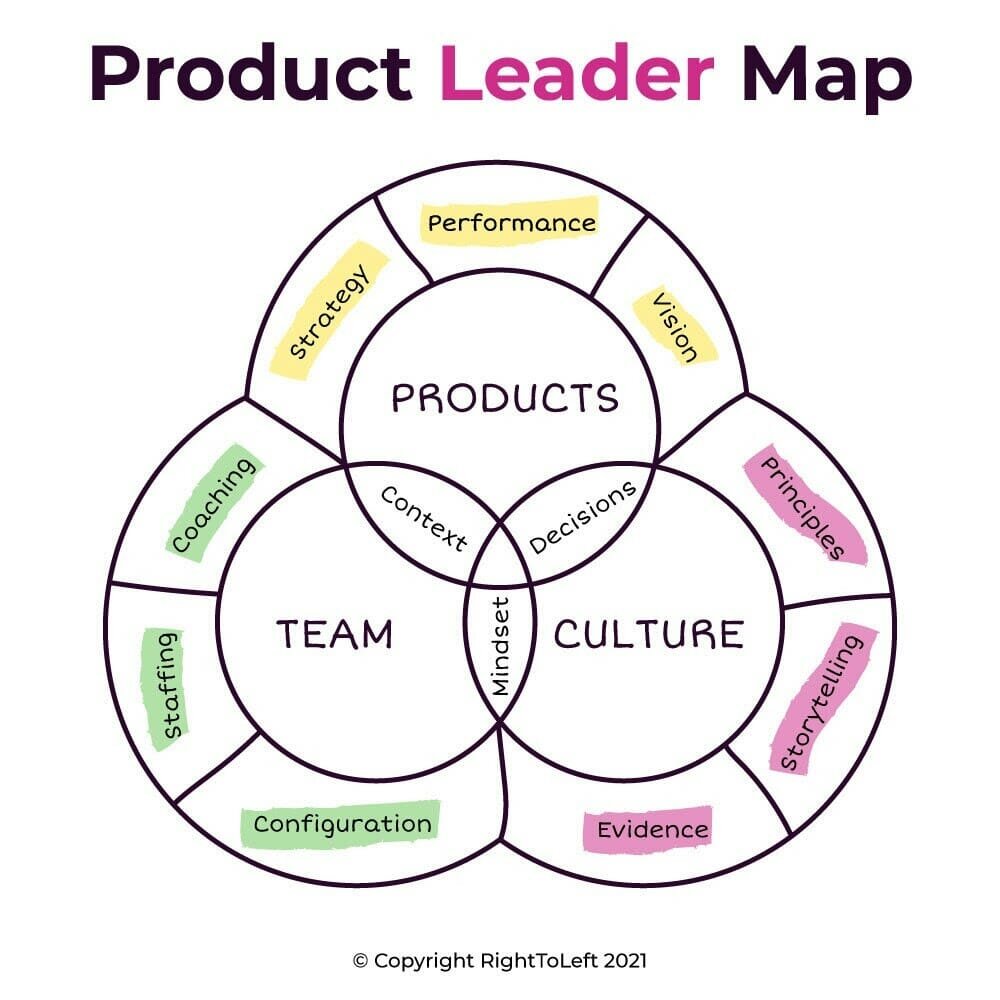"I’m drowning in a never-ending todo list", "I can’t be everywhere at once", "I’m not good enough". In my coaching work I constantly hear these frustrations from product leaders. It's no surprise – product leadership is a tough gig, but strong product leadership is vital if companies are to be product-led and achieve growth. Below, I share my Product Leader Map, a way to set product leaders up for success.
Introducing The Product Leader Map
Product people love frameworks. They help us to be better practitioners and improve our effectiveness. We’re all familiar with the three circles of the Venn diagram for product managers – business, design and technology – and it’s clear we need similar guidance for product leaders. My Product Leader Map uses the familiar three-circle layout, to highlight the essential areas: products, culture, and team. Most product leaders are looking for:
- Delightful, profitable and long-lived products
- Capable, focused and happy cross-functional team
- Purposeful, collaborative and can-do culture
To achieve the above, you need to provide clear contextual understanding to teams about each product, guardrails for decision-making, and encourage a modern product mindset. Sounds simple, right?
To help you, the Product Leader Map shows three topics for each area. Evaluating the topics is the start to building a 90-day improvement plan to help you level up your product function. As we explore each topic, consider the three key questions below:
- How much room for improvement is there?
- How much impact would the improvement have on my teams?
- How much impact would the improvement have on the customers or the business objectives?
Products
The product area on the map has three topics; vision, strategy, and performance.
Product Vision
Product vision provides your teams and the organisation with clarity on where you are going: it should describe what great looks like. There are many models available to help you construct a product vision, but when crafting your vision you should consider the following:
- Is the vision simple and easy to understand?
- Is it exciting and bold?
- Can you explain it in one or two concise sentences?
Product Strategy
Product strategy shares the big strategic bets to get the company closer to the vision. It is typically a one to three-year horizon, depending on the development of the company and the product. A pre-market fit product will not deserve a three-year strategy as you will not have enough knowledge about the market or solution. The strategy must be kept to high-level big bets, communicating where the team's energy should be invested – it should not imply the solution. Again, as with vision, this must be simple and easy for everyone to understand. Product strategy and vision empower teams with the context of the problems they are working on, and together with strategic objectives, give teams guidance to make trustworthy decisions.
Performance
Transparent, honest understanding or product performance is critical for everyone to have full context and informed decision-making. Performance should provide insights into customer interactions, the measure of customer experience, leading metrics to revenue and complete financial performance.
Product Team
The Team area on the map has three topics: configuration, hiring and coaching.
Configuration
Product team configuration, sometimes called topology, can be the root cause for issues like the speed of delivery and staff motivation.
There are many options for structuring team responsibility. You may choose the customer journey stage, or persona, or technical architecture. The complexity of the team structure will change according to scale, and if you reach a large scale with a single product line, you will eventually need teams focused on aspects of infrastructure, client application, and function. The goal is a team that can own a problem and deliver a solution independently. This means minimising the inter-team dependencies. In my experience, product managers have the least context switching, and therefore highest efficiency when they focus on a single customer.
Hiring
Don’t underestimate how hard it is to hire people. Get it wrong, and you will have very uncomfortable conversations, and have to ask people to leave. There’s a considerable cost to an organisation in having toxic staff on a team; leaders regularly avoid dealing with this and ignore its impact on productivity, motivation, and culture. Attitude is the key attribute to look for when hiring, skills are secondary as they can be developed, but attitude is slow to change. Attitude determines culture fit for your team.
Similar to attitude is emotional intelligence, or EQ. Low EQ will impact a product manager’s capacity to influence and reduce the likelihood they are effective.
Hiring the right level of experience is important, knowing where to deploy more junior roles provides a better shape to your teams. You must also avoid the trap of hiring people similar to yourself, instead hire for diversity, it always builds stronger teams.
Coaching
An effective leader coaches regularly. Coaching enables you to flex the muscles you developed as a product manager and to influence process adoption, behaviour and personal development. It is a powerful tool that all leaders should study and practise. While mentoring is important, coaching is more powerful and keeps you out of the workings. There are some popular “coaching for performance” models that encourage autonomy and embed a rapid test and learn mindset to find the next best action, aligned to a modern product mindset. Coaching your staff will build happier and better performing and teams.
Product Culture
Culture has three topics: principles, storytelling and evidence.
Principles
Principles are a robust agreement, best written down, between the leader and the team. Like any agreement, they are two-way, and you must live them every day and ensure you don’t break them. Some principles are created collaboratively with the teams, others are dictated by the leader, and a mix is healthy. Usually, product principles are concerned with beliefs of how modern product management should function, for example – celebrate small successes, experiment to inform decisions with evidence, and so on. However, some will be specific to the organisation and technology decisions, such as Amazon’s Jeff Bezos famous API Mandate which insists all teams expose data and functionality through a service or get fired.
Storytelling
How people behave in an organisation is influenced by many things, none as powerful as the stories leaders tell. The stories you chose to share – and the stories you chose not to share – have an enormous influence on your organisation’s culture. If you want to influence a customer-first evidence-based mindset, you need to tell stories about companies and individuals who do this. As a leader, you need to recognise the impact of your opinions and actions. Your teams and the broader organisation are always watching you.
Evidence
Modern product culture is an evidence-informed culture. How is evidence shared in your organisation? Do experiments that fail and thus save a team from wasting effort in building the wrong things get celebrated? Or because it showed there was a false idea, does it get swept under the rug? As a leader, you need to ensure there are spaces and mechanisms for shared and reviewed evidence. This accumulation of evidence is valuable IQ and using it correctly will give your organisation a competitive edge.
Putting it all Together
We’ve run through all nine topics, now comes the fun part.
You need to pick one topic from each area (products, team, culture) to focus on. Don’t be tempted to select two or three from one area. It is far more effective to focus your attention in a balanced way. By selecting three topics, you have the bare bones for your 90-day improvement plan. The next step is to define clear outcomes for all three topics that you believe your teams can achieve over 90 days. Armed with a list of outcomes (feels like a product roadmap), now you are ready to collaborate with your peers and teams to plan the actions.
Put this article in your calendar to read again in 90 days so that you can re-evaluate and reset your product leadership focus. Continuous improvement isn’t just for engineers coding!
MTP leaders can learn more
In an interactive AMA session for MTP Leaders, Dave joined Mind the Product's Managing Director, Emily Tate, to discuss how product leaders can achieve success using The Product Leader Map. Watch Achieve success with the Product Leader Map in full.









